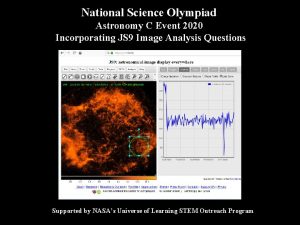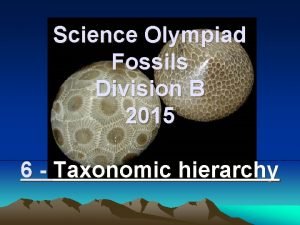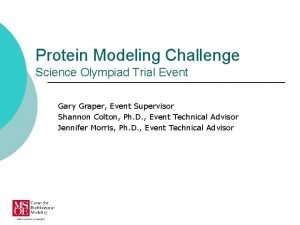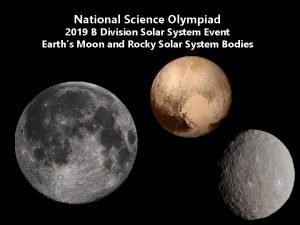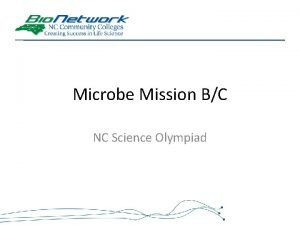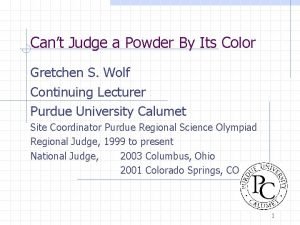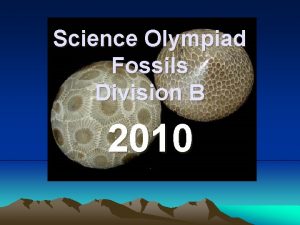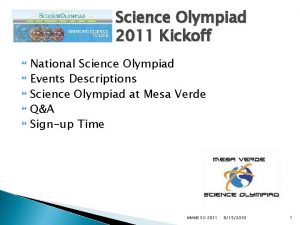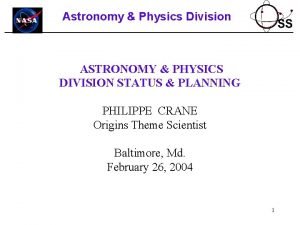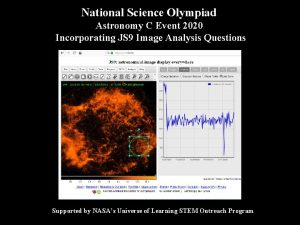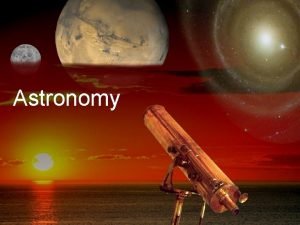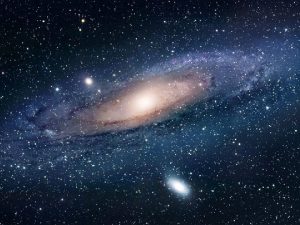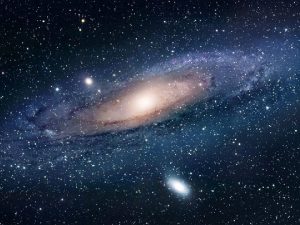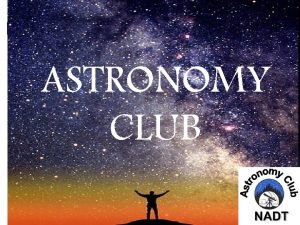Science Olympiad Astronomy Division C Guidelines Description Students
























- Slides: 24

Science Olympiad Astronomy Division C

Guidelines �Description: Students will demonstrate an understanding of the basic concepts of mathematics and physics relating to stellar evolution and Type II Supernova. �A team of up to: 2 �Approximate Time: 50 minutes

Guidelines �Event Parameters: Each team may bring either 2 laptops or 2 3 -ring binder containing info in any form from any source �Materials must be 3 -hole punched and inserted into the rings �Each team member is permitted to bring a programmable calculator �NO INTERNET ACCESS!

The Competition �Using H-R Diagrams, spectra, light curves, motions, cosmological distance equations and relationships, stellar magnitudes and classification, multi-wavelength images (XRay, UV, optical, IR, radio), charts, graphs, animations and DS 9 imaging analysis software, students will answer questions

Competition (Part A) �Stellar evolution, including spectral features and chemical composition, luminosity, blackbody radiation, color index (B-V), and HR Diagram transitions, stellar nurseries and star formation, protostars, main sequence stars

Competition (Part A) cont. �Cepheid variables, semiregular variables, red supergiants, neutron stars, magnetars, pulsars, Wolf-Rayet stars, stellar mass black holes, x-ray binary systems and Type II Supernovas

Stellar Evolution �Lifespan of a star and radical changes �Dependent on mass �Ranges from few million years to trillions of years �All stars born from collapsing clouds of gas and dust

Star Classification �HR Diagram

Kepler’s Laws �Kepler’s First Law: Planets move around the sun in ellipses, with the Sun in one focus �Kepler’s Second Law: the line connecting a planet to the Sun sweeps equal areas in equal times �Kepler’s Third Law: The square of a planet’s sidereal period (P) around the Sun is directly proportional to the cube of the length of its orbit’s semimajor axis (a) �P 2 = a 3, planet closer to the Sun has a shorter year

Kepler’s Laws cont. �Use laws, rotation and circular motion to answer questions relating to orbital motions of binary and multiple star systems �Use parallax, spectroscopic parallax, and the distance modulus to calculate distances to Type I and II Cepheids

Cepheid variables �Cepheid variable stars expand contract in a repeating cycle of size changes �Change in size is comparable with change in brightness

Competition (Part c) �Identify, know the location and answer questions relating to the content areas outlined above for following object: Cas A, IGR J 17091, NGC 6888/WR 136, PSR J 0108 - 1431, Cygnus X-1, SXP 1062, M 1, V 838 Mon, Delta Cep, a Orionis, SN 2010 JL, NGC 3582, LHa 115 N 19, Antares/Rho Ophiuchi cloud complex and IC 1396

Cassiopeia A (Cas A) �Remnant of a massive star that exploded about 300 years ago � 10 light years in diameter � 50 million degrees

IGR J 17091 �Binary system containing stellar mass black hole �Black hole pulling gas away from a companion star

NGC 6888/WR 136 �Nebula

PSR J 0108 -1431 �Solitary Pulsar located in constellation Cetus � 424 Light years away

Cygnus X-1 �Well known galactic X-ray source in Cygnus constellation

SXP 1062 �Supernova in constellation Tucana � 180, 000 Light years away

Messier 1 (M 1) �Crab nebula

V 838 Monocerotis �Constellation Monoceros �Red variable star

Delta Cep �Binary Star System � 887 Light years away

Alpha Orionis

Scoring �All questions will have been assigned a predetermined number of points. The highest score wins. Selected questions having differentiated weights will be used to break ties.

Resources �Aavso. org �Chandra. harvard. edu �Antwrp. gsfc. nasa. gov �Nightsky. ie �Atlasoftheuniverse. com �Email Astronomy professor from IUN at lciupik@adlerplanetarium. org
 Js9 imaging analysis software
Js9 imaging analysis software Learning astronomy by doing astronomy
Learning astronomy by doing astronomy Learning astronomy by doing astronomy activity 1 answers
Learning astronomy by doing astronomy activity 1 answers Learning astronomy by doing astronomy
Learning astronomy by doing astronomy Detector building science olympiad cheat sheet
Detector building science olympiad cheat sheet Junior science olympiad
Junior science olympiad Fossils science olympiad 2019
Fossils science olympiad 2019 Anatomy science olympiad
Anatomy science olympiad Science olympiad forensics cheat sheet
Science olympiad forensics cheat sheet Business modeling olympiad
Business modeling olympiad Science olympiad ornithology
Science olympiad ornithology Milky way galaxy
Milky way galaxy Microbe mission science olympiad
Microbe mission science olympiad Green generation science olympiad
Green generation science olympiad Science olympiad gravity vehicle rules
Science olympiad gravity vehicle rules Georgia science olympiad
Georgia science olympiad Can't judge a powder
Can't judge a powder Southern california science olympiad
Southern california science olympiad Science olympiad wright stuff kit
Science olympiad wright stuff kit Birdso scilympiad
Birdso scilympiad Science olympiad machines
Science olympiad machines Science olympiad boomilever
Science olympiad boomilever Environmental chemistry science olympiad
Environmental chemistry science olympiad Best material for ping pong parachute
Best material for ping pong parachute Science olympiad san diego
Science olympiad san diego
